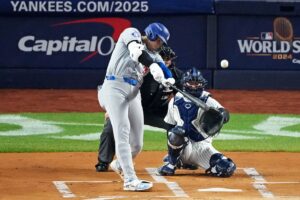The Zimmerman Chase and World Series of 1917
U-boats and the Zimmermann Telegram
World War I had been raging for nearly three years when Great Britain intercepted an encrypted telegram. The telegram was sent from the German Foreign Minister Arthur Zimmermann, to the German minister to Mexico Heinrich Von Eckhart. The British deciphered the message and found that it proposed an alliance between Germany and Mexico. The Germans were offering–if the U.S. joined the war on the side of the allies–support to the Mexicans in reclaiming what was once theirs. Nearly seventy years earlier, Mexico had lost a massive amount of territory to the U.S. as a result of the Mexican-American War. And now they were being given a chance to take it back.
The British saw their opportunity to coax the U.S. into the war on the side of the allies and sent their findings to the U.S. government. The Zimmermann telegram, coupled with German U-boat attacks on U.S. merchant and passenger ships, was enough to break U.S. neutrality. By mid-1917 some 14,000 U.S. troops had landed on the shores of France.
The 1917 World Series
Interlude
Against the backdrop of World War I, the Chicago White Sox and New York Giants were set to play the 1917 World Series. U.S. troops were seeing their first combat while the likes of Shoeless Joe Jackson, Chick Gandil, and Buck Weaver were facing off against John McGraw and his Giants. This would be the last World Series played by the White Sox before they were given the Black Sox moniker in 1919.
On the other hand, the Giants were hungry to win and hoping to shake the string of bad luck that they had faced in years past. From the Merkle boner to the Snodgrass muff, their postseason dealings had fallen short in an embarrassing way. McGraw, the Giants pugnacious manager, was looking to erase these follies and bring the championship back home to New York. However, against a Sox team that had won 100 games, the Giants would have their work cut out for them.
The Series
On October 6th and 7th Comiskey Park was packed with Chicagoans for the first two games. The White Sox jumped out to an early 2 – 0 series lead behind the pitching of Eddie Cicotte and Red Faber. The contest then moved to New York for Game Three with Cicotte back on the mound for the Sox. Eddie threw his second complete game of the series, but failed to come out on top, losing to the more masterful, Rube Benton, who shutout Chicago. Game Four followed suit and the Giants evened up the series on another shutout by pitcher Ferdie Schupp. All tied up at two apiece, they headed back to the windy city.
Chicago won Game Five, 8 – 7 on a couple of 7th and 8th inning rallies, leaving the Sox one win away from the championship. Unfortunately for the Giants, Game Six proved to be the third in a series of postseason blunders (think Merkle and Snodgrass) that led to their four straight series loss.
Say It Ain’t So, Heinie
A Brief Bio
Heinie Zimmerman was the Giants third baseman in 1917 and a Triple Crown winner with the Chicago Cubs in 1912. Since his spectacular season in ’12, Zimmerman was known for his sometimes lackadaisical play and he never quite reached the brilliance of his Triple Crown season. The Cubs eventually tired of Heine’s lollygagging and traded him to the Giants in 1916. He had a good season in 1916 leading the National League in RBI with 83. Zimmerman continued his success with the Giants in 1917. He once again led the league in RBI with 102 and helped propel the Giants to their first World Series since 1913.
Game Six and The Zimmerman Chase
Merkle’s Boner and Snodgrass’s Muff were still fresh in the public’s mind when the fourth inning of Game Six came about. Eddie Collins, the White Sox second baseman, hit a grounder to Zimmerman. Heinie came up with it, but made a bad throw to first, allowing Collins to advance to second. Then Giants right fielder, Dave Robertson, dropped a “Shoeless” Joe fly ball. Collins advanced to third on the error and Jackson made it to second safely. That left runners on second and third base with no outs. Happy Felsch, who had batted .308 on the season, came to the plate for Chicago. He grounded one back to the New York pitcher, Rube Benton.
And here is where it gets a bit sticky.
Benton cleanly fielded the ground ball and caught Collins in no-man’s-land, breaking early for home. Benton then threw to Zimmerman at third and caught Collins in a rundown. Zimmerman threw to catcher, Bill Rariden, who chased Collins back toward third. Rariden then threw the ball back to Zimmerman. Collins, being the crafty base runner that he was, managed to slip past Rariden with a clear path to home.
Should the path to home have been clear?
The answer is no.
Giants first baseman, Walter Holke, or the pitcher, Benton, should have been backing up the play. But, they weren’t, leaving Zimmerman to unsuccessfully chase down the speedier Collins. Collins scored what would turn out to be the game winning run. Series over. Chicago wins! Chicago wins!
Was Zimmerman at fault?
Well, no, but he was blamed either way. Another boner.
Or was he to blame?
Boner or Wager
Over the years, Zimmerman’s consistent diddling left many to question his authenticity. After the Giants picked up Hal Chase, a well-known thrower of games, Zimmerman became his sidekick and took to propositioning other players. Word eventually reached McGraw, who suspended both players.
If not for the follies of the Chicago White Sox in the 1919 World Series, Zimmerman may have been able to get away with his lack of integrity. However, the public was outraged with the Black Sox scandal and baseball was determined to clean up its act. In September of 1920, a grand jury was assembled to investigate gambling in baseball and Zimmerman’s actions. That along with Chase’s actions were all a part of the discussion. McGraw testified against Zimmerman and Zimmerman admitted to offering bribes to players, although he claimed he was doing it on behalf of a Chicago gambler. Regardless of Zimmerman’s excuses, his confession of involvement was enough and he was banned from baseball along with Chase.
Was Zimmerman in on a fix during the 1917 series or was he just lazy? After batting .297 and leading the NL in RBI, Heine’s batting fell off during the series. He hit just .120 and committed three errors along with his infamous chase. Boner or wager we may never know, but we do know that Zimmerman was a great ballplayer who was susceptible to erratic play. From the Merkle Boner to the Snodgrass Muff to the Zimmerman Chase, the postseason bad luck continued for the Giants. Or was it bad luck? We may never know.
Main Image:
Embed from Getty Images
Players Mentioned: Shoeless Joe Jackson, Chick Gandil, Buck Weaver, John McGraw, Eddie Cicotte, Red Faber, Rube Benton, Ferdie Schupp, Heinie Zimmerman, Eddie Collins, Dave Robertson, Happy Felsch, Bill Rariden, Walter Holke, Hal Chase.






